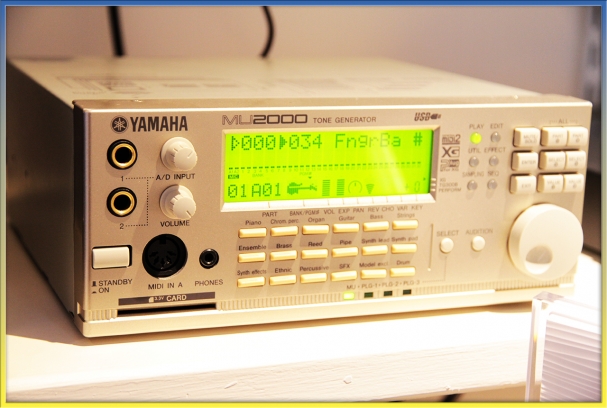Yamaha MU-2000EX
A Tonally Turbocharged Multi-Timberal Giant
Another Ebay acquisition, this time from a Japanease dealer in all manner of shapeable synthetics, the Mu-2000 is physically the squattest, most button laden box of assorted vibrations in my possession. It also boasts the distinction of being the studio’s only non Roland rompler, sitting snugly atop of its slimmest spur shelf.
Yamaha’s “MU” hierarchy took root in 1994 with their modestly specified Mu5, a basic and belated practitioner of General Midi folklore wholly deprived of effects. Between its emergence and that of the Mu-2000, the company launched over a dozen descendants, consistently adding twists of timbrel treacle, dollops of drumming delectation and a steady stream of tonal tonic.
An emphatic response to Roland’s radical remix of GM monotony abruptly materialised in the form of XG , known as “Extended General Midi” and in an effort to extinguish its rival’s three year head start, the enhancements bestowed upon its earliest adopter were greater proportion and scope.
The MU-80’s orchestra comprised 729 pieces, from which the maestro could command a up to of 64 aspiring soloists at once, armed with an amalgam of 32 unique instruments with which to tout their talents. That is truly the last voices, tones and parts analogy I’m prepared to dredge up in this or any future article!
By the time the MU2000 emerged, appropriately at the turn of the millennium, the vocal variety had grown to 1396, delectable drum kits totalled 47. Polyphonic powers had evolved to 128 and multitimbral might to 64. A band approaching the opulence of that commanded by the SC-8850 but with and a brace of digital credentials the latter lacked, as well as native sequencing and sampling abilities.
Proficient from the outset in the practices of General Midi and General Midi 2*, a firmware update, partially licensed by Roland, supplanted the unit’s “TG300B” mode with an official GS instrument map, widely considered as authentic as any and claimed by some to outsing a genuine SC-55. The upgrade also welcomed an influx of new effects and was copious enough for Yamaha to re-christen its flagship as the MU-2000 “EX” when still in production. Factory models flaunting the revised name are extremely rare.
Shortly after boxes ceased rolling off the line, the firmware became available to the public, though the procedure for its implementation proved perilously complicated, could only be executed under specific operating systems, in multiple stages, using several applications and most importantly, carried a high risk of terminal damage to the relevant EEPROMS. Needless to say, I was mindful to verify its presence prior to purchase.
The built in sampler provided 4mb of storage space, 48 seconds of total recording time and 512 spaces for user customised patches.
The MU’s portfolio of effects is, in quantitative terms, the most staggering of all the synths adoring my shelves. A high quality 5 band EQ is joined by 18 reverb and 20 chorus colourations of a relatively common breed, which are accompanied by jaw dropping stash of “variation” algorithms and 4 extended families of insertion tweaks, each bursting at the staves with an astonishing coda of 97 pre-sets, riddled with rotarys, flangers, panners, phasers, EQ’s, pitch shifters, amplifiers, isolators, vocal suppressors, compressors and three way combinations of those mentioned and dozens more.
Like our three aforementioned heroes of electric harmonics, multiple effects were enforceable on a per part basis. Reverb and Chorus presets could be ascribed to serve any quota of parts and their levels independently governed.
Variation algorithms could either be globally delegated in the same fashion or directed to individual parts depending on a special setting accessible via the “effects” menu. “Insert” mode engaged part specific operation, whereby the selected effect was consigned to single parts at a fixed level, while “system” mode ensured the effect could be administered to a sole or multiple part(s) in exclusively variable quantities.
Insertion effects were also allotted in fixed amounts and to one part at a time while a quartet could be freely assembled and designated according to taste. Four to four parts, a combination of three to one part, one to another, two pairs to two parts and finally a subtle or sensational collage of all four to a lone and lucky part. For those who haven’t kept count, that’s a Fantom and SD-90 beating chain of seven simultaneous effects.
Standalone mode, as with so many romplers of the era, was activated by a rear mounted switch that facilitated additional “PC-2” and “MAC” operating states, none of which necessitated a reboot to apply.
Ten universally praised plug-in boards from Yamaha’s “PLG-100” and PLG-150 series were all readily welcomed by the 2000, with room for three lodgers at once, each supplementing their hosts polyphony with their own fully serviceable stash of samples.





